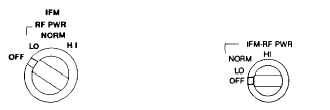|
| |
TM 11-5821-333-12
2-10. RT/RCU CONTROLS, INDICATORS, AND CONNECTORS. Continued
IFM RF PWR. This switch is used to remotely control the output power level of the IFM power amplifier, Radio
sets that do not have an IFM power amplifier should keep this switch at OFF. Otherwise, sidetone is disabled.
RECEIVER-TRANSMITTER
RADIO SET CONTROL
OFF. The IFM power amplifier is not used and the RF output
LO (low). The IFM power amplifier output is 2.5 W.
NORM (normal). The IFM power amplifier output is 10 W.
HI (high). The IFM power amplifier output is 40 W.
is 10 W.
KEYBOARD. Lets operator “talk” to RT. Used for loading or checking data
ICOM KEYBOARD
NON-ICOM KEYBOARD
FREQ. Makes display show RT SC frequency or FH data. Used also for SC frequency
loading. Used in late net entry procedures.
ERF (SEnd). Used to transmit ERF.
OFST, Used to check and load SC offset frequency,
•••/TIME. TO be used by NCS only to check and load FH sync time clock. This should not be used by net
members. When pressed three times, makes display show days (first press), hours and minutes (sec-
ond press), and minutes and seconds (third press),
STO (Sto/ENT), Used for SC frequency and FH data loading. Transfers data from RT holding memory
into RT permanent memory.
NOTES
STO is commonly pronounced “stow”, although it means “store”. It
should not be confused with “stow” as it appears on the function switch.
LOAD (H-Ld). Used to move FH data from permanent memory to the holding memory.
data from a fill device,
CLR. Clears data from keyboard display and permanent memory.
Used to load FH
LOUT (L). Used to retrieve or clear a selected lockout set from permanent memory.
SYNC (L.E.). Used for FH late net entry procedure.
0 through 9 numbers. Used to enter numbers 0 through 9.
2-7
|


